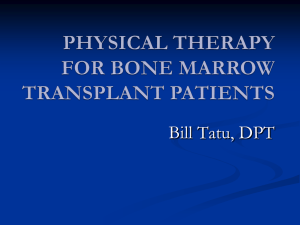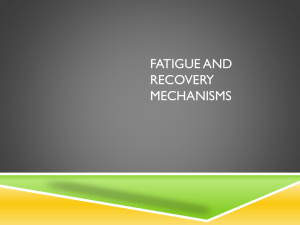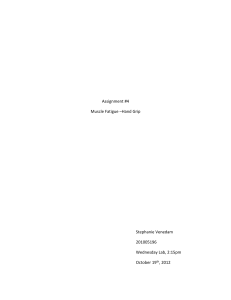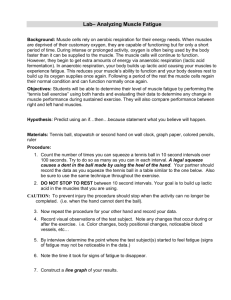Muscle Histology
advertisement
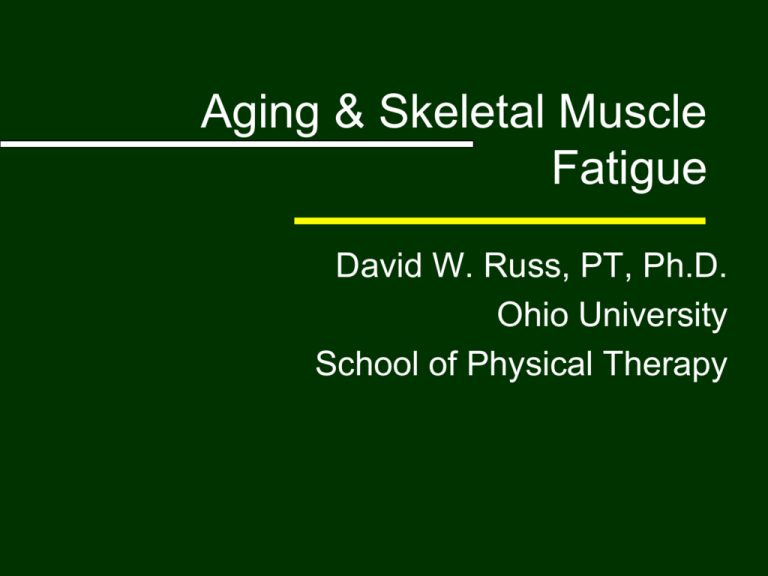
Aging & Skeletal Muscle Fatigue David W. Russ, PT, Ph.D. Ohio University School of Physical Therapy Skeletal Muscle “Without skeletal muscle, there is no physical therapy.” --Eugene Michels Muscle Fatigue Definitions: #1 Change in maximum forcegenerating capacity of muscle with use #2 Ability to maintain required or expected force during repetitive and/or prolonged use – Task Failure Muscle Fatigue: Definition 1 Maximum Effort Or electrically-stimulated Isolated muscle or muscle group Isometric or dynamic Sustained or intermittent Fixed time of exercise Relative (percentage) Degrees of fatigue Top: Lanza et al, 2004 Bottom: Stevens et al, 2001 Muscle Fatigue: Definition 2 Typically submaximal Potentially any functional or exercise task Output is kept fixed, time to task failure is principal variable Fatigue is binary For certain protocols, Definitions 1 & 2 can be combined Cheng et al, 2003 Loss of Force Common factor in each definition How is muscle force generated? Pretty complicated… Central Drive Recruitment Rate Coding Peripheral Excitation Signal Modulation Ascending/ Descending inputs Crossbridge Formation FORCE! N.M. Transmission T-tubule Propagation Calcium Release TnC Binding Muscle Fatigue “Fatigue makes cowards of us all.” • V. Lombardi Multiple sites of failure Multiple potential mechanisms Task specificity Single mechanism not likely Impact of Muscle Fatigue Quadriceps strength Transient loss of was a significant strength factor in completion of Reduced muscular ADLs in 16 frail endurance was elderly (Brown, et al., 1995) significantly Lower extremity associated with a power positively history of falls in older women (Schwender predicted functional et al., 1997) independence in community-dwelling elderly (Bean et al., 2002, Suzuki et al., 2001) Functional Outcomes Strength is associated with higher performance on tests that are used as predictors of function (6 min walk, Timed get-up-and-go, etc.) Petrella et al, 2004 Visser et al, 2000 Judge et al, 1996 Studies of Muscle Fatigue Older subjects (65-85 yrs) Matched for physical activity Dorsiflexors Isometric • Submax – “ramp” • MVC • 50% and 70% duty cycle Dynamic • Isokinetic (90 s-1) Outcome measures MVC force • Also power for dynamic Central Activation Peripheral Excitability/NMJ Contractile Properties Age-related differences Baseline Changes with fatigue Fatigue Data Russ et al., 2008 Kent-Braun et al., 2002 Lanza et al., 2004 Central Activation Testing 200 2.00 170 1.50 Force (N) 0.50 110 0.00 80 -0.50 50 -1.00 20 -10200 -1.50 700 1200 1700 2200 2700 -2.00 2.00 140 1.50 1.00 0.50 80 0.00 50 -0.50 -1.00 20 -1.50 -10200 1200 2200 3200 4200 -2.00 EMG (mV) 110 EMG (mV) 1.00 140 Force (N) No study showed age-related deficits Testing is not simple to do in the clinic Peripheral Excitability M-wave Compound Muscle Action potential (CMAP) Amplitude & Area Again, age appears unimportant 12.00 8.00 4.00 0.00 250 350 450 550 650 750 850 -4.00 -8.00 emg (mV) 6.00 3.00 0.00 70 -3.00 90 110 130 150 170 Contractile Properties Stimulated contractions Twitches or trains Contraction time Half-relaxation time Maximum rates scaled for force • force development (+df/dt) • relaxation (-df/dt) Twitch Potentiation Contractile properties and muscle fiber type Contractile property data are consistent with global shift to slow, Type I myosin heavy chain • Correlation between fatigue resistance and force relaxation Type I fibers are fatigue resistant Also slower, reduce power Evidence for increase in Type I fiber area &/or number with age Likely muscle specific Generalizability Healthy, older subjects Minimal medications No co-morbidities Sedentary, but activity matched Muscle specificity Results corroborated in other muscles • Stevens et al 2001; Allman & Rice, 2004 Few data in upper extremities Task specificity & Function Increased time to task failure with age (endurance) • Hunter et al., 2005 May not relate to whole body exercise • Reduced cardiac output with age So why do older adults complain of fatigue? Reduced physical activity Muscle oxidative capacity maintained relative to young when activity is comparable Strength relative to function in the environment Although more fatigue-resistant, elders are weaker (15-25% MVC deficits) Absolute vs. relative tasks Strength, Fatigue & Functional performance Younger subject Quads produce 800N Needs 300N to stairs Fatigues 60% Can produce 320N and still perform task Older Subject Quads produce 400N Needs 300N to stairs Fatigues 30% Can only produce 280N – task cannot be performed Aging & Muscle Fatigue Studies that control for physical activity tend to indicate that older subjects fatigue no more, and perhaps less than young subjects. Submaximal and functional fatigue tasks may require a greater percentage of exercise capacity of older subjects and produce greater fatigue/earlier task failure Exercise Interventions Endurance Exercise: May not be an issue from the aspect of muscle fatigue • Older muscle tends to be fatigue resistant • Will mitigate the effects of disuse, but probably not aging per se Plenty of other good reasons to do it • Cardiovascular • Insulin Sensitivity Strength training is probably more of an issue Exercise Interventions Focus on strength not size Sarcopenia is real However weakness tends to exceed loss of mass Capacity for hypertrophy persists with age • Blunted – work more for smaller gains • Resistance exercise increases mixed muscle protein synthesis (Balogapal, et al., 2001; Hasten et al., 2000; Yarasheski et al., 1993) • “Functional Resistance” protocol increased myofibrillar area (Cress et al., 1996) Central Drive Recruitment Rate Coding Peripheral Excitation Signal Modulation Ascending/ Descending inputs Crossbridge Formation FORCE! Potential areas of action Calcium Release TnC Binding N.M. Transmission T-tubule Propagation Many Thanks Jane Kent-Braun Ian Lanza Danielle Wigmore Ted Towse
